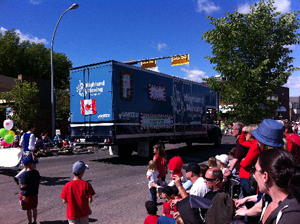Canada is signatory to an international protocol that requires heat treated wood to be used for all pallets and containers shipped to other countries. Since 2006, Canada has had a bilateral exemption for wood packaging material crossing our southern border, however the United States has proposed the removal of this exemption by mid-2012. This will mean that ALL wood packaging material entering the US will require an IPPC stamp.
Please see the latest press release issued by CFIA on February 14, 2011.
The Canadian Food Inspection Agency (CFIA) and the United States Department of Agriculture’s Animal and Plant Health Inspection Service (USDA-APHIS) are moving forward to remove the current exemption for wood packaging being shipped between the two countries, as outlined in the International Standard for Phytosanitary Measures (ISPM) No. 15. This action is necessary to prevent the introduction of new forest pests, as well as slow the spread of forest pests already established in North America.
http://www.inspection.gc.ca/english/corpaffr/newcom/2011/20110214e.shtml
Implementation of the International Standard for Phytosanitary Measures No. 15 (2009) for Wood Packaging Material Moving Between Canada and the United States
OTTAWA, February 14, 2011 : The Canadian Food Inspection Agency (CFIA) and the United States Department of Agriculture’s Animal and Plant Health Inspection Service (USDA-APHIS) are moving forward to remove the current exemption for wood packaging being shipped between the two countries, as outlined in the International Standard for Phytosanitary Measures (ISPM) No. 15. This action is necessary to prevent the introduction of new forest pests, as well as slow the spread of forest pests already established in North America.
This standard requires wood packaging to be heat-treated or fumigated with methyl bromide. Wood packaging moving between Canada and the continental United States has been exempted from this requirement because it was thought that existing pest-specific regulatory controls were providing sufficient protection.
With a number of invasive species being introduced into the two countries, the CFIA and the USDA-APHIS have jointly agreed to begin enforcing the international standard.
Canada and the United States are working together on implementation of the standard, including a phased-in approach based on consultation processes in each country.
After implementation, shipments with wood packaging material found to be non-compliant will not be permitted to enter the country of destination. If live pests are detected, the importer may also be required to treat the shipment to prevent pest escape, before having it returned to the country of origin.
Canada adopted ISPM No. 15 in 2004, to prevent invasive species from outside North America being introduced into Canada.
The Canadian Food Inspection Agency (CFIA) has instituted two export certification programs, the Canadian Wood Packaging Certification Program (CWPCP), and the Canadian Heat Treatment Wood Products Certification Program (CHTWPCP) to certify Canadian wood packaging producers, Canadian wood packaging treatment facilities, and Facilities registered under the CHTWPCP, to produce ISPM No. 15 compliant wood packaging material.
Approved producers and treatment facilities will mark their products with an ISPM No. 15 compliant approved wood packaging certification stamp.
The CFIA approved wood packaging certification stamp can only be applied by a facility registered under one of these two programmes.
What does this mean for international transportation of Household Goods & Personal Effects?
Proper overseas packing, wrapping and preparation of your household goods is one of the most important steps to ensuring a successful move. Due to the nature of these goods it is necessary for us to provide custom crating when required. These crates both protect and secure the goods while in transit. Wood provides the strength necessary and the use of timber wood cuts costs and adds further strength. We also require dunnage material within sea containers to build bulkhead, decks and blocking. Our crating and dunnage is a combination of manufactured wood products and timber making it necessary for us to be part of the Canadian Wood Packaging Certification Program.
When looking for international expertise it is imperative that your mover complies with these government regulations. Starline Overseas Moving is one of two professional moving companies in Alberta that meet the specialized requirements for this program.
For more information on the implementation of ISPM No. in Canada, please visit www.inspection.gc.ca
The Government of Canada is committed to protecting our forests by preventing the introduction and spread of invasive plant pests, which can seriously harm Canada’s environment, forests and plant resources.
For information:
Canadian Food Inspection Agency
Media relations: 613-773-6600










